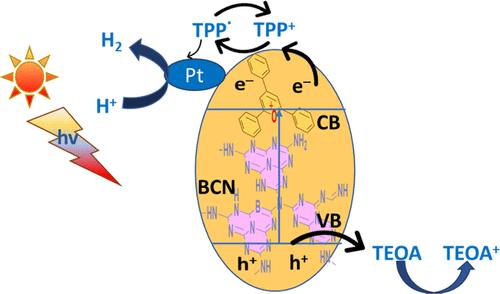当前位置:
X-MOL 学术
›
ACS Appl. Nano Mater.
›
论文详情
Our official English website, www.x-mol.net, welcomes your
feedback! (Note: you will need to create a separate account there.)
Hydrogen Production from Water Splitting with 2,4,6-Triphenylpyrylium Modified on B-Doped N-Deficient Carbon Nitride Nanostructures
ACS Applied Nano Materials ( IF 5.3 ) Pub Date : 2024-06-21 , DOI: 10.1021/acsanm.4c02713 Tania Tofaz 1 , Ikram Ullah 1 , Sadia Habib 1 , Jing-Han Li 1 , Shuai Chen 1 , Xiao-Jie Lu 1 , Ghulam Murtaza 1 , Hao-Yang Ding 1 , An-Wu Xu 1
ACS Applied Nano Materials ( IF 5.3 ) Pub Date : 2024-06-21 , DOI: 10.1021/acsanm.4c02713 Tania Tofaz 1 , Ikram Ullah 1 , Sadia Habib 1 , Jing-Han Li 1 , Shuai Chen 1 , Xiao-Jie Lu 1 , Ghulam Murtaza 1 , Hao-Yang Ding 1 , An-Wu Xu 1
Affiliation

|
A solar-driven hydrogen production process using a graphitic carbon nitride (CN) photocatalyst is an ideal future clean energy source. However, hydrogen production efficiency in the CN photocatalytic system is still limited due to rapid electron–hole (e−/h+) recombination. Herein, we report an efficient photocatalyst BCN-TPP by introducing 2,4,6-triphenylpyrylium (TPP) to boron-doped nitrogen-deficient carbon nitride (BCN) through π–π interaction and π–cation interaction. The as-prepared photocatalyst shows increased visible light absorption and narrow band gap, enhancing the separation of photogenerated e–/h+ pairs. TPP acts as a redox mediator under visible light excitation that can accept electrons from BCN, and then transfer them to the Pt cocatalyst. Photoluminescence (PL), electron paramagnetic resonance (EPR), and other electrochemical studies have exhibited that introducing a TPP mediator significantly enhances photogenerated charge carrier separation. BCN-TPP (10 wt % TPP) nanostructures achieved the photocatalytic H2 generation rate of 110.33 μmol h–1 at visible light illumination (λ ≥ 420 nm), which is 9.59 times higher than that of pristine C3N4 (11.50 μmol h–1) and the apparent quantum efficiency (AQE) of 6.03% at 450 nm. Moreover, BCN-TPP shows the stability of H2 evolution over 4 cycles without any significant decline. This study represents an approach for designing efficient nanoheterostructured photocatalysts for hydrogen production from water splitting.
中文翻译:

B 掺杂氮缺陷碳纳米结构改性 2,4,6-三苯基吡喃鎓水裂解制氢
使用石墨氮化碳(CN)光催化剂的太阳能制氢工艺是未来理想的清洁能源。然而,由于电子-空穴(e − /h + )快速复合,CN光催化系统中的产氢效率仍然受到限制。在此,我们通过π-π相互作用和π-阳离子相互作用将2,4,6-三苯基吡喃鎓(TPP)引入硼掺杂的氮缺乏的氮化碳(BCN)中,报道了一种高效的光催化剂BCN-TPP。所制备的光催化剂表现出增加的可见光吸收和窄带隙,增强了光生 e – /h + 对的分离。 TPP 在可见光激发下充当氧化还原介体,可以接受来自 BCN 的电子,然后将其转移到 Pt 助催化剂。光致发光(PL)、电子顺磁共振(EPR)和其他电化学研究表明,引入TPP介体可显着增强光生电荷载流子分离。 BCN-TPP(10 wt % TPP)纳米结构在可见光照射(λ ≥ 420 nm)下的光催化产氢率 2 达到110.33 μmol h –1 ,提高了9.59倍比原始的 C 3 N 4 (11.50 μmol h –1 )和 450 nm 处的表观量子效率(AQE)为 6.03%。此外,BCN-TPP 显示了 4 个循环中 H 2 演化的稳定性,没有任何显着下降。这项研究代表了一种设计用于水分解制氢的高效纳米异质结构光催化剂的方法。
更新日期:2024-06-21
中文翻译:

B 掺杂氮缺陷碳纳米结构改性 2,4,6-三苯基吡喃鎓水裂解制氢
使用石墨氮化碳(CN)光催化剂的太阳能制氢工艺是未来理想的清洁能源。然而,由于电子-空穴(e − /h + )快速复合,CN光催化系统中的产氢效率仍然受到限制。在此,我们通过π-π相互作用和π-阳离子相互作用将2,4,6-三苯基吡喃鎓(TPP)引入硼掺杂的氮缺乏的氮化碳(BCN)中,报道了一种高效的光催化剂BCN-TPP。所制备的光催化剂表现出增加的可见光吸收和窄带隙,增强了光生 e – /h + 对的分离。 TPP 在可见光激发下充当氧化还原介体,可以接受来自 BCN 的电子,然后将其转移到 Pt 助催化剂。光致发光(PL)、电子顺磁共振(EPR)和其他电化学研究表明,引入TPP介体可显着增强光生电荷载流子分离。 BCN-TPP(10 wt % TPP)纳米结构在可见光照射(λ ≥ 420 nm)下的光催化产氢率 2 达到110.33 μmol h –1 ,提高了9.59倍比原始的 C 3 N 4 (11.50 μmol h –1 )和 450 nm 处的表观量子效率(AQE)为 6.03%。此外,BCN-TPP 显示了 4 个循环中 H 2 演化的稳定性,没有任何显着下降。这项研究代表了一种设计用于水分解制氢的高效纳米异质结构光催化剂的方法。






























 京公网安备 11010802027423号
京公网安备 11010802027423号